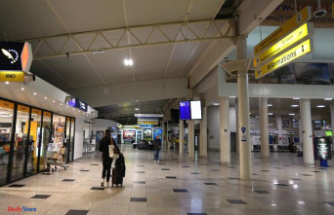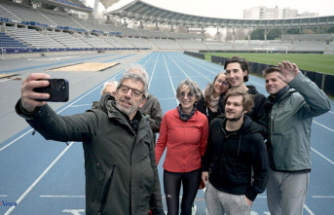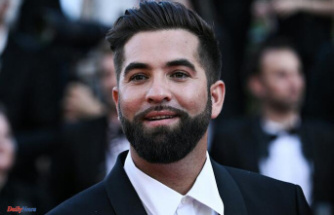MADISON (Wis.) -- The prosecution of Kyle Rittenhouse has introduced surveillance video from an FBI plane circling at thousands of feet above the chaos as evidence.
Rittenhouse was the one who killed Joseph Rosenbaum, Anthony Huber, and injured Gaige Grosskreutz in an August 2020 demonstration in Kenosha. His trial began Monday. Rittenhouse claims he fired in self defense after the men assaulted him. Prosecutors claim he placed himself in a volatile situation, and that video from his plane will show that he chased Rosenbaum.
Here are some examples of government efforts to monitor people's activities via the air.
HAS THE GOVERNMENT USED PLANES TO MONITOR PAST TESTS?
Yes. Yes. A report by the Air Force Inspector General in August 2020 states that the National Guard used surveillance aircraft to monitor protests in Washington, D.C., Arizona, California, and Minnesota after George Floyd's May death in Minneapolis.
After the shooting death of Michael Brown in 2014, the FBI used an aircraft to monitor protests in Ferguson (Missouri) and Baltimore (Baltimore) to follow protests after Freddie Gray's 2015 police custody death. Democrat Barack Obama was president at both of these events. In 2017 , law enforcement used aerial surveillance to watch a white nationalist rally at Charlottesville, Virginia. It turned deadly. Republican Donald Trump was also president at the time.
In 2015, an Associated Press investigation found that the FBI had constructed a fleet of at most 50 surveillance aircrafts that flew over 11 states in a span of one month during the Obama administration's spring. The Associated Press traced the planes back to at least 13 fake companies to conceal the identities of the pilots and aircraft.
The AP review found that Obama's Drug Enforcement Administration had at most 92 surveillance planes as of 2011. The U.S. The U.S. Marshals Service has also operated an aerial surveillance program.
Ashley Gorski is an American Civil Liberties Union attorney who specializes on surveillance issues. She stated that government agencies flew more surveillance missions during Black Lives Matter protests last January, when Trump was president.
She said, "The result was particularly aggressive." It seems that the response was unexpected and unorthodox.
WHAT KIND OF TECHNOLOGY DO PLANES USE
The pilots can capture video of the scene below them with standard cameras and infrared sensors. These sensors pick up body heat and provide enough resolution to show basic vehicle features and movement such as people riding or walking bicycles. These planes can also carry technology that mimics cellphone towers. This allows agencies to track the location of people's phones even when they aren't making calls or out in public. The technology was originally developed to be used by the U.S. military, in Iraq, as part of a project called Gorgon Stare. It is named after the mythical Greek monster that could make men stone.
Agencies can use video images even if they are blurry to uncover people's identities.
Is this legal?
Yes, generally. According to William McGeveren, a University of Minnesota professor who specializes on data privacy and freedom of speech, aerial surveillance of public persons is legal. He said that surveillance by government agencies does not require a warrant.
The U.S. Supreme Court decided in 2018 that any extended surveillance of an individual across a large area was illegal. The 4th U.S. Circuit Court of Appeals ruled that Baltimore Police Department's six month trial of aerial surveillance was illegal because of the wide-angle cameras on the planes. This meant that all residents of Baltimore were under surveillance 12 hours a days. After Black activists sued, the city received this ruling.
Limitations can be imposed by government agencies on their programs. According to the Air Force report, the National Guard did not receive the authorization from either the secretary or the Army to conduct aerial surveillance on Floyd protests. The FBI's Milwaukee field office is responsible for Kenosha. A spokesperson for that office didn't respond immediately to a request for comment. The FBI's national press officer also did not respond to an email.
What's the problem if AERIAL SURVEILLANCE is legal?
This surveillance allows police to respond quickly to violent demonstrations and can identify and arrest criminals after the fact, protecting public security.
Civil rights activists fear that this surveillance could lead to government agencies monitoring people's movements, making it more difficult for people to leave their homes and be seen interacting with others at political functions. This would violate constitutional freedom of speech or association guarantees. Two military helicopters swooped over protesters at the Floyd protest in Washington last year, unleashing high-speed winds from their rotors on protestors.
The very existence of these programs can cause trust to be eroded, particularly among Black leaders. For example, one of the Black plaintiffs in Baltimore argued that she regularly visits crime scenes and was concerned that surveillance programs would lead to police collecting specific information.
WHAT IMPACT CAN THE AERIAL VIDEO HAVE ON RITTENHOUSE?
It is too early to know. Prosecutors claim that Rittenhouse will be seen following Rosenbaum in the video. This could possibly help to discredit Rittenhouse's claims of self-defense. On Tuesday, portions of an infrared video that prosecutors showed in court -- taken from almost 9,000 feet -- showed dozens small, fuzzy and blurred images of people moving and standing along streets and sidewalks.
On Wednesday, a Kenosha detective testified that Rosenbaum was "hiding" at the time Rittenhouse arrived at that spot. Richards described the confrontation as "the classic ambush", words which were used after the prosecution objected but were heard by jurors.












